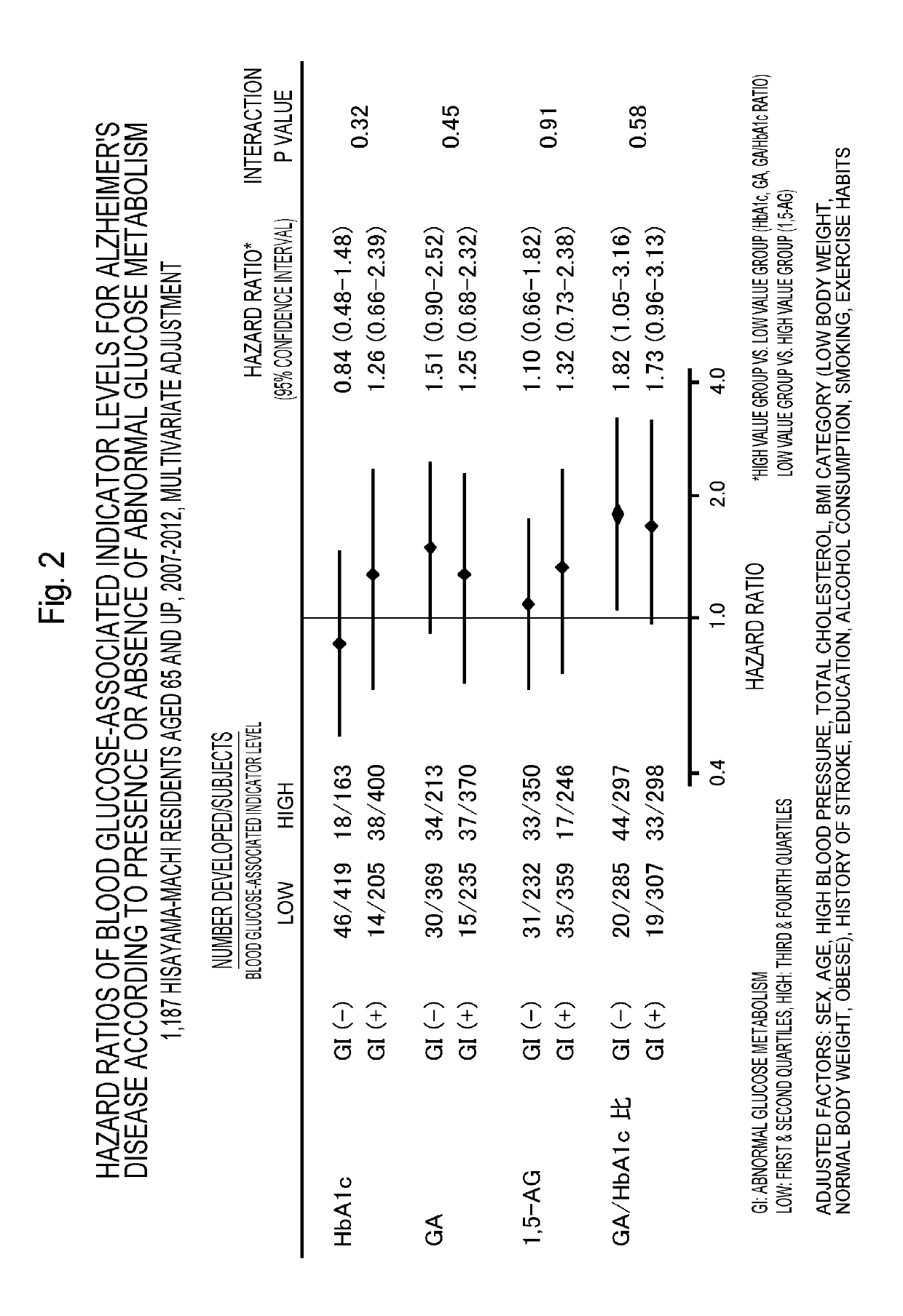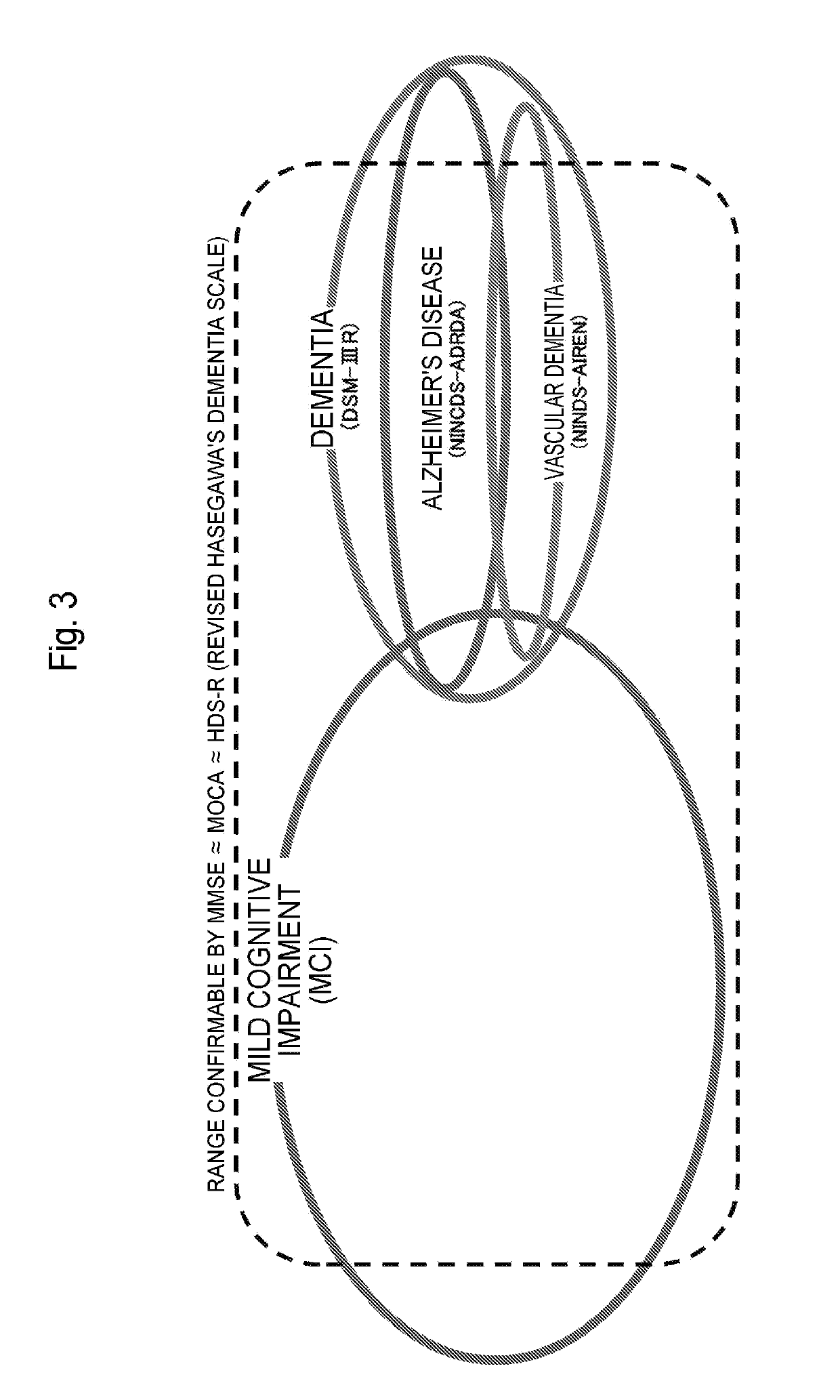Method for determining alzheimer's disease risk
a risk factor and alzheimer's disease technology, applied in the direction of material analysis, biological material analysis, instruments, etc., can solve the problems of increasing medical and nursing care expenses, significant socioeconomic losses, and complex actual diagnosis, and achieve the effect of accurately easily, quickly and cheaply
- Summary
- Abstract
- Description
- Claims
- Application Information
AI Technical Summary
Benefits of technology
Problems solved by technology
Method used
Image
Examples
example 1
[0159]Hazard Ratios for Alzheimer's disease Onset According to Levels of Blood Glucose-Associated Indicators
[0160]Of the residents aged 65 and older who received a cardiovascular checkup in Hisayama-machi in 2007, 1,187 individuals without dementia were followed prospectivelyf for 5 years. The subjects were separated into 4 quartiles (Q1 to Q4) according to their hemoglobin A1c, glycoalbumin and 1,5-anhydroglucitol levels and glycoalbumin / hemoglobin A1c ratios. The end point was the onset of Alzheimer's disease or vascular dementia. The Cox proportional hazard model was used to calculate the hazard ratio (HR). Alzheimer's disease was diagnosed by the diagnostic criteria of the National Institute of Neurological and Communicative Disorders and Stroke and the Alzheimer's Disease and Related Disorders Association (NINCDS-ADRDA) (Non-Patent Document 2: Guy McKhann et al., Clinical diagnosis of Alzheimer's disease, Neurology 1984, 34:939-944), and vascular dementia by the clinical standa...
example 2
Hazard Ratios of Blood Glucose-Associated Indicator Levels for Alzheimer's Disease According to Presence or Absence of Abnormal Glucose Metabolism
[0187]The hazard ratios (after multivariate adjustment) of each blood glucose-associated indicator level in Alzheimer's disease onset were calculated depending on the presence or absence of abnormal glucose metabolism (diabetes+pre-diabetes) under the same conditions as in Example 1. As a result, in the group without abnormal glucose metabolism the high glycoalbumin / hemoglobin A1c ratio groups (Q3 and Q4) had significantly higher hazard ratios (1.82, p=0.03) for Alzheimer's disease onset than the low-ratio groups (Q1 and Q2), and the same tendency was seen in the group with abnormal glucose metabolism (FIG. 2, hazard ratio 1.7, p=0.07). However, no significant relationship was found between Alzheimer's disease onset and hemoglobin A1c, glycoalbumin or 1,5-anhydroglucitol regardless of whether there was abnormal glucose metabolism (p>0.1 in...
example 3
Calculating Cut-Off Values for Glycoalbumin / Hemoglobin A1c Levels in Alzheimer's Disease Onset
[0190]Cut-off values and sensitivity / specificity of glycoalbumin and glycoalbumin / hemoglobin A1c levels were determined for Alzheimer's disease onset using ROC (receiver operating characteristics curve) analysis under the same conditions as in Example 1. The results are shown in Table 1.
TABLE 1Cut-off values for blood glucose-associated indicators in Alzheimer'sdisease onset(1,187 Hisayama residents aged 65 and older, 2007-2012, ROC analysis)BG-associatedindicatorCut-off valueSensitivity (%)Specificity (%)GA15.8%55.2%59.9%GA / HbA1c2.8565.5%53.3%
[0191]As shown in Table 1, the glycoalbumin / hemoglobin A1c ratio cut-off value for detecting Alzheimer's disease is 2.85, with a sensitivity of 65.5% and a specificity of 53.3%. These results show that the glycoalbumin / hemoglobin A1c ratio is a biomarker for Alzheimer's disease, and that the presence or absence of Alzheimer's disease can be predicted ...
PUM
 Login to View More
Login to View More Abstract
Description
Claims
Application Information
 Login to View More
Login to View More - R&D
- Intellectual Property
- Life Sciences
- Materials
- Tech Scout
- Unparalleled Data Quality
- Higher Quality Content
- 60% Fewer Hallucinations
Browse by: Latest US Patents, China's latest patents, Technical Efficacy Thesaurus, Application Domain, Technology Topic, Popular Technical Reports.
© 2025 PatSnap. All rights reserved.Legal|Privacy policy|Modern Slavery Act Transparency Statement|Sitemap|About US| Contact US: help@patsnap.com



